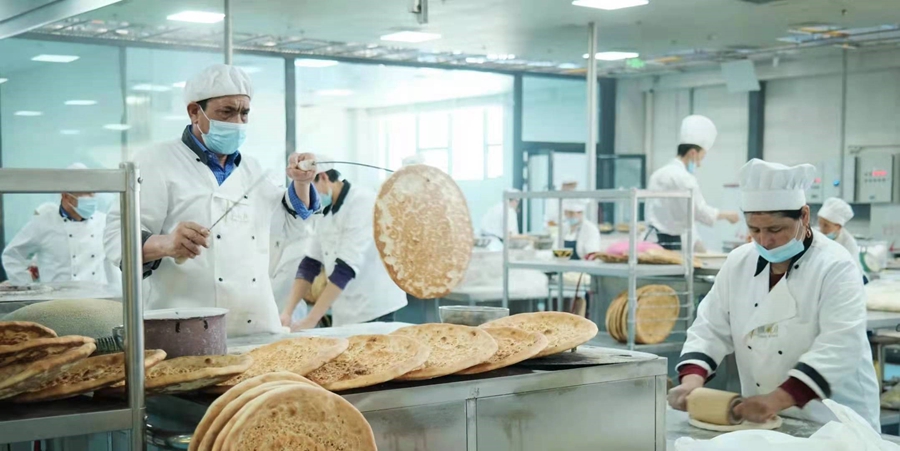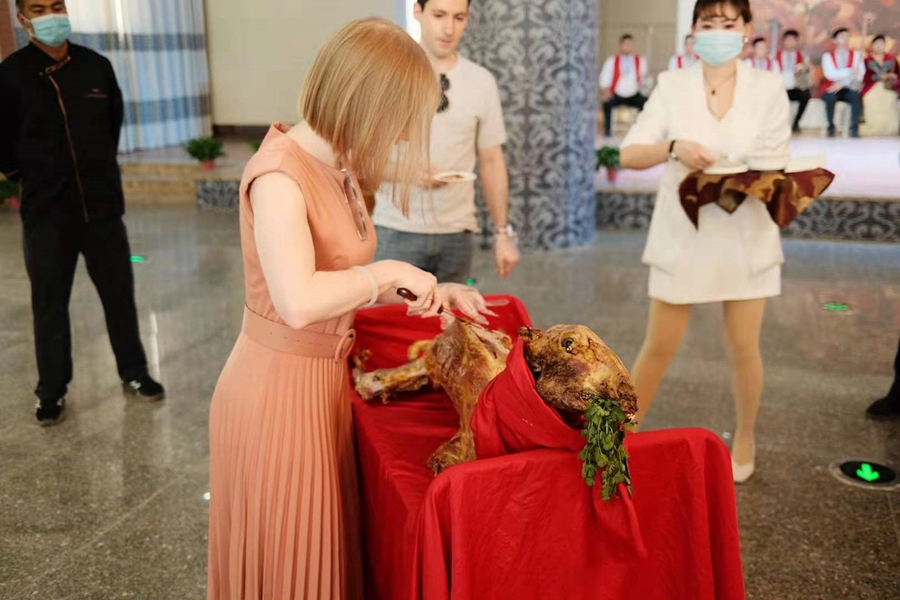A culinary journey through Xinjiang
There is a saying in Germany: “The way to a man’s heart is through his stomach.”
During my journey in Xinjiang, I have been very excited about all the different kinds of food they served, and I have to admit that I fell in love not at first bite, but let’s say at the third or fourth.

Picture taken in the yard of a local resident, showing a traditionally arranged eating area. (People’s Daily Online/Annemarie Li)
Starting the day with a glass of hot milk or pure yoghurt along with honey, fresh fruits and nuts was so refreshing, and gave me the power I needed for this journey. Due to the rich agriculture industry in Xinjiang, most of the local dishes are made with fresh ingredients that definitely bring out their full flavors. A major branch of local agriculture is the fruit industry, for example cultivation of grapes, raisins, watermelon, jujubes and pears. Due to the intense sunlight during the daytime and the low temperatures at night, the fruits are extremely sweet. In fact, I can say that I have never tasted such sweet grapes before.

Freshly baked naan bread produced at a local naan production site in Xinjiang. (People’s Daily Online/Zhang Ruohan)
Besides fresh food, I have also been treated with lots of local specialties, as they were usually served in small bowls during the meals. I really liked the pilaf - a famous rice dish served with locally dried raisins and sautéed carrots. One of my favorite side dishes was baked nang bread, which to my eyes is very similar to Western pizza bread. It is a handmade grain product that appears in all shapes and sizes, and replaces steamed rice as a side dish.
While visiting one of the biggest nang factories in the region, I learned that there are more than one hundred different varieties, and a real nang bread culture exists. One might prefer the traditional savory method of serving it with sesame, sunflower seeds or even meat and egg. But I personally preferred the sweet combination of nang bread with yoghurt and honey.

Roasted lamb served for a celebratory lunch at the Folk Instrument Village in Kashgar. (People’s Daily Online/Zhang Ruohan)
Meat-lovers in particular will enjoy their culinary journey here, as Xinjiang offers so many dishes for them to try: barbecue sticks, steamed dumplings, baked dumplings, nang stuffed with meat – the list is just as long as their variety of tastes. Did you know that the most famous meat in Xinjiang is lamb?
What was also astonishing to me was that every fourth bottle of tomato ketchup uses tomatoes from Xinjiang. The special cultivar is apparently the best suited to produce tomato paste as it is rich in firm flesh. So from now on, I will always be reminded of the fascinating and charming places I visited in Xinjiang when enjoying French fries together with the sweetish red sauce.
Photos
Related Stories
- Construction of first cross-desert expressway in Xinjiang proceeds smoothly
- Corban Festival celebrated in China's Xinjiang
- ‘Pairing assistance’ program in China introduces fruits from Xinjiang to rest of the country
- China pools resources to help Xinjiang achieve moderate prosperity
- Kodak apologizes over Instagram post that claims Xinjiang is under ‘acute repression’
Copyright © 2021 People's Daily Online. All Rights Reserved.










